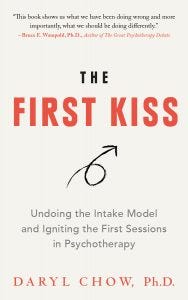The 4P’s versus The 1P
Updates by Daryl Chow, MA, Ph.D.(Psych)
View this email in your browser
The 4P’s versus The 1P
By Daryl Chow, MA, PhD on Jul 04, 2018 02:28 pm
Here’s chapter 4 of the book, The First Kiss. eBook is released today. Happy 4th of July to all American readers!
“Our highest priority is to protect our ability to prioritise”
~ Greg Mckeown, Essentialism p. 101.
The Intake Model sees several essentials. While the Engagement Model narrows down to one essential.
The traditional pedagogy based on a biopsychosocial perspective schools us to develop the 4 P’s: Predisposing, Precipitating, Perpetuating, and Protective factors about our clients.
We must go beyond that. In order to engage our clients, we must train ourselves to spot the essential.
When we have two or more priorities, we lose any sort of focus. In the book Essentialism, Greg Mckeown points out that 500 years ago, only the singular pronoun “Priority” existed. It was only at the turn of the 18th century that the plural “priorities” entered our English lexicon.1
We have to filter down from 4 P’s to 1 P.
What is one thing that my client needs help from me right now and is willing to work on in the first session?
We may start broad, but we cannot end the first session without narrowing things down. The Intake Model exists in a framework that assumes clients are motivated to return for subsequent sessions. The Engagement Model believes that trust is earned and not a given.
The Intake Model assumes there are a couple of priorities at play. The Engagement Model priorities figuring out what is the highest priority. It uses blinders like on a racehorse, not to restrict its vision, but to keep focused. An intentional constraint2 keeps you focused on your client’s priority.
In the Engagement Model, the law of sacrifice3—giving up something of lesser value in order to attain something of greater value—is at work. You might not get to comprehend a person’s attachment history if he is experiencing anxiety right now. Neither would you be able to attain a complete psycho-social history and the details of every heartbreak he has encountered.
The Engagement Model is not blind. It recognises that most clients do not just have one problem. It simply orders, ranks, and prioritises. It assumes that our ability to resonate and target their highest concern draws them into the ritual of therapy, one session at a time.
If you don’t use Kindle (mobi), the ebook also available in other ebook formats (epub, pdf). Click on image.
Footnotes:
1 I highly recommend reading Greg Mckeown’s book in its entirety. Mckeown, G. (2014). Essentialism: The disciplined pursuit of less. Great Britain: Random House Group Company.
2 See Adam Morgan and Mark Baden’s 2015 book, A Beautiful Constraint. Morgan, A., & Barden, M. (2015). A beautiful constraint: How to transform your limitations into advantages and why it’s everyone’s business. New Jersey: Wiley.
3 See The Art of Manliness blogpost on the law of sacrifice.
Recent Articles:
The Perils of an Intake Model
Intake Second (Not First)
Undoing the Intake Model in Psychotherapy
What Therapy Is (Or Isn’t).
The Personal and The Professional






